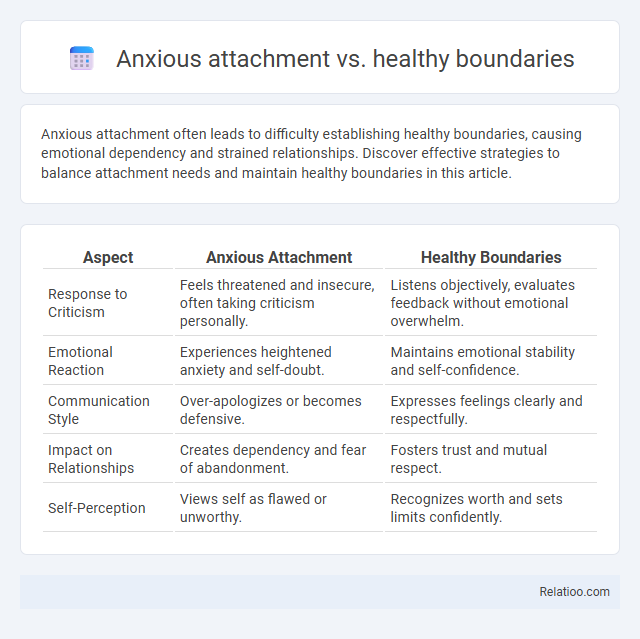Anxious attachment often leads to difficulty establishing healthy boundaries, causing emotional dependency and strained relationships. Discover effective strategies to balance attachment needs and maintain healthy boundaries in this article.
Table of Comparison
| Aspect | Anxious Attachment | Healthy Boundaries |
|---|---|---|
| Response to Criticism | Feels threatened and insecure, often taking criticism personally. | Listens objectively, evaluates feedback without emotional overwhelm. |
| Emotional Reaction | Experiences heightened anxiety and self-doubt. | Maintains emotional stability and self-confidence. |
| Communication Style | Over-apologizes or becomes defensive. | Expresses feelings clearly and respectfully. |
| Impact on Relationships | Creates dependency and fear of abandonment. | Fosters trust and mutual respect. |
| Self-Perception | Views self as flawed or unworthy. | Recognizes worth and sets limits confidently. |
Understanding Anxious Attachment
Anxious attachment is characterized by a deep fear of abandonment and a strong desire for closeness, often leading to clingy or needy behaviors that can strain relationships. Healthy boundaries help individuals maintain a balanced sense of self, preserving personal space and emotional autonomy while fostering secure connections. Understanding anxious attachment allows You to recognize your emotional triggers and develop strategies to establish healthy boundaries, promoting emotional well-being and more stable relationships.
Key Signs of Anxious Attachment
Key signs of anxious attachment include constant fear of abandonment, excessive need for reassurance, and difficulty trusting others, which often disrupts your relationships. Unlike healthy boundaries that promote self-respect and emotional balance, anxious attachment can lead to clinginess and emotional dependency. Recognizing these signs helps differentiate anxious attachment from secure relational patterns and supports developing healthier interpersonal dynamics.
What Are Healthy Boundaries?
Healthy boundaries are defined as clear, respectful limits individuals establish to protect their emotional well-being and maintain balanced relationships. Unlike anxious attachment, which is characterized by a fear of abandonment and excessive need for reassurance, healthy boundaries promote autonomy and mutual respect without fear or excessive dependency. Establishing healthy boundaries involves recognizing personal needs, communicating them assertively, and fostering relationships based on trust and emotional safety rather than anxiety-driven behaviors.
Differences Between Anxious Attachment and Healthy Boundaries
Anxious attachment is characterized by fear of abandonment and excessive need for reassurance, while healthy boundaries involve clear limits that protect your emotional well-being without creating dependence. Unlike anxious attachment, healthy boundaries promote self-respect and mutual respect in relationships, preventing codependency and emotional exhaustion. Understanding these differences helps you cultivate relationships based on security rather than anxiety or control.
How Anxious Attachment Affects Relationships
Anxious attachment often leads to a heightened need for reassurance and fear of abandonment, which can create tension and misunderstandings in relationships. Healthy boundaries help maintain emotional security by balancing closeness and independence, reducing the anxiety-driven behaviors linked to anxious attachment. You can improve your relationships by recognizing anxious attachment patterns and establishing clear boundaries to foster trust and emotional stability.
The Role of Boundaries in Secure Relationships
Boundaries play a crucial role in differentiating anxious attachment from healthy relationships by providing clear limits that foster security and trust. Individuals with anxious attachment often struggle with setting or respecting boundaries, which can lead to emotional dependence and insecurity. Establishing and maintaining your own healthy boundaries promotes emotional resilience and supports secure, balanced connections.
Overcoming Anxious Attachment Patterns
Overcoming anxious attachment patterns involves recognizing the difference between anxious attachment and healthy boundaries, where anxious attachment often leads to fear of abandonment and excessive need for reassurance, while healthy boundaries foster self-respect and emotional regulation. Your journey to healing requires developing self-awareness, practicing assertive communication, and setting clear limits to reduce dependency on others for validation. Strengthening emotional resilience and seeking therapy or support groups can further aid in cultivating secure connections and maintaining balanced relationships.
Strategies for Establishing Healthy Boundaries
Establishing healthy boundaries for individuals with anxious attachment involves clear communication of personal needs and limits to reduce dependency and insecurity in relationships. Strategies include practicing assertiveness, recognizing emotional triggers, and setting consistent rules that prioritize self-care without fear of rejection. Incorporating mindfulness and therapy techniques can strengthen emotional regulation and promote balanced connections, differentiating healthy boundaries from anxious attachment patterns.
Healing from Anxious Attachment Through Boundaries
Healing from anxious attachment involves establishing healthy boundaries that promote emotional safety and self-respect. Healthy boundaries help individuals with anxious attachment regulate their emotional responses and reduce dependency on others for validation. Incorporating clear limits in relationships fosters resilience and supports the development of secure attachment patterns over time.
Building Secure and Respectful Connections
Anxious attachment often leads to seeking excessive reassurance, which can blur healthy boundaries and create emotional dependency. Establishing healthy boundaries fosters mutual respect and clear communication, essential for building secure and respectful connections. You can cultivate stable relationships by balancing emotional needs with personal limits, promoting trust and emotional safety.

Infographic: Anxious attachment vs Healthy boundaries
 relatioo.com
relatioo.com